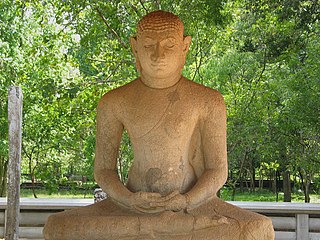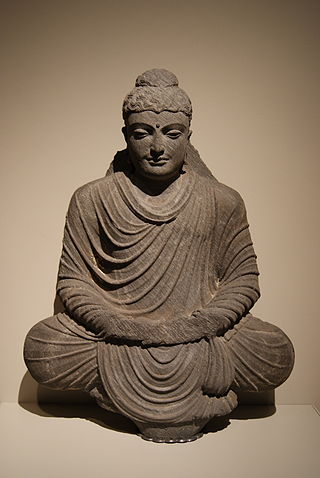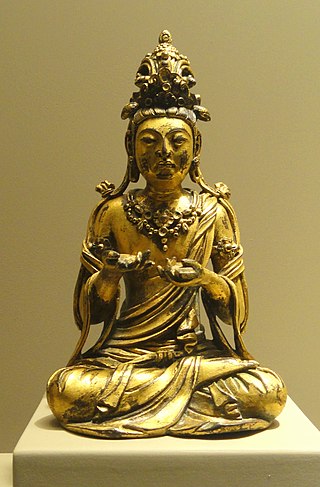
Meditation is a practice in which an individual uses a technique – such as mindfulness, or focusing the mind on a particular object, thought, or activity – to train attention and awareness, and achieve a mentally clear and emotionally calm and stable state.

The Eightfold Path is an early summary of the path of Buddhist practices leading to liberation from samsara, the painful cycle of rebirth, in the form of nirvana.
Theravāda is the most commonly accepted name of Buddhism's oldest existing school. The school's adherents, termed Theravādins, have preserved their version of Gautama Buddha's teaching or Buddha Dhamma in the Pāli Canon for over two millennia.

Samādhi, in Buddhism, Hinduism, Jainism, Sikhism and yogic schools, is a state of meditative consciousness. In Buddhism, it is the last of the eight elements of the Noble Eightfold Path. In the Ashtanga Yoga tradition, it is the eighth and final limb identified in the Yoga Sutras of Patanjali.

Ānāpānasati, meaning "mindfulness of breathing", paying attention to the breath. It is the quintessential form of Buddhist meditation, attributed to Gautama Buddha, and described in several suttas, most notably the Ānāpānasati Sutta.
Satipatthana is a central practice in the Buddha's teachings, meaning "the establishment of mindfulness" or "presence of mindfulness", or alternatively "foundations of mindfulness", aiding the development of a wholesome state of mind. In Theravada Buddhism, applying mindful attention to four domains, the body, feelings, the mind, and key principles or categories of the Buddha's teaching (dhammās), is thought to aid the elimination of the five hindrances and the development of the seven aspects of wakefulness.

Mahāsī Sayādaw U Sobhana was a Burmese Theravada Buddhist monk and meditation master who had a significant impact on the teaching of vipassanā (insight) meditation in the West and throughout Asia.

Prajñā or paññā, is a Buddhist term often translated as "wisdom", "intelligence", or "understanding". It is described in Buddhist texts as the understanding of the true nature of phenomena. In the context of Buddhist meditation, it is the ability to understand the three characteristics of all things: anicca ("impermanence"), dukkha, and anattā ("non-self"). Mahāyāna texts describe it as the understanding of śūnyatā ("emptiness"). It is part of the Threefold Training in Buddhism, and is one of the ten pāramīs of Theravāda Buddhism and one of the six Mahāyāna pāramitās.
Mindfulness is the practice of purposely bringing one's attention to the present-moment experience without evaluation, a skill one develops through meditation or other training. Mindfulness derives from sati, a significant element of Hindu and Buddhist traditions, and is based on Zen, Vipassanā, and Tibetan meditation techniques. Though definitions and techniques of mindfulness are wide-ranging, Buddhist traditions explain what constitutes mindfulness such as how past, present and future moments arise and cease as momentary sense impressions and mental phenomena. Individuals who have contributed to the popularity of mindfulness in the modern Western context include Thích Nhất Hạnh, Herbert Benson, Jon Kabat-Zinn, Richard J. Davidson, and Sam Harris.

Satya Narayana Goenka was an Indian teacher of Vipassanā meditation. Born in Burma to an Indian business family, he moved to India in 1969 and started teaching meditation. His teaching emphasized that the Buddha's path to liberation was non-sectarian, universal, and scientific in character. He became an influential teacher and played an important role in establishing non-commercial Vipassana meditation centers globally. He was awarded the Padma Bhushan by the Government of India in 2012, an award given for distinguished service of high order.

Buddhist meditation is the practice of meditation in Buddhism. The closest words for meditation in the classical languages of Buddhism are bhāvanā and jhāna/dhyāna.
Bhāvanā literally means "development" or "cultivating" or "producing" in the sense of "calling into existence". It is an important concept in Buddhist practice (Patipatti). The word bhavana normally appears in conjunction with another word forming a compound phrase such as citta-bhavana or metta-bhavana. When used on its own, bhavana signifies contemplation and 'spiritual cultivation' generally.

The Visuddhimagga, is the 'great treatise' on Buddhist practice and Theravāda Abhidhamma written by Buddhaghosa approximately in the 5th century in Sri Lanka. It is a manual condensing and systematizing the 5th century understanding and interpretation of the Buddhist path as maintained by the elders of the Mahavihara Monastery in Anuradhapura, Sri Lanka.
The Vipassanā movement, also called the Insight Meditation Movement and American vipassana movement, refers to a branch of modern Burmese Theravāda Buddhism that promotes "bare insight" (sukha-vipassana) to attain stream entry and preserve the Buddhist teachings, which gained widespread popularity since the 1950s, and to its western derivatives which have been popularised since the 1970s, giving rise to the more dhyana-oriented mindfulness movement.
Sati, literally "memory" or "retention", commonly translated as mindfulness, "to remember to observe," is an essential part of Buddhist practice. It has the related meanings of calling to mind the wholesome dhammas such as the four establishments of mindfulness, the five faculties, the five powers, the seven awakening-factors, the Noble Eightfold Path, and the attainment of insight, and the actual practice of maintaining a lucid awareness of the dhammas of bodily and mental phenomena, in order to counter the arising of unwholesome states, and to develop wholesome states. It is the first factor of the Seven Factors of Enlightenment. "Correct" or "right" mindfulness is the seventh element of the Noble Eightfold Path.
The Ānāpānasati Sutta (Pāli) or Ānāpānasmṛti Sūtra (Sanskrit), "Breath-Mindfulness Discourse," Majjhima Nikaya 118, is a discourse that details the Buddha's instruction on using awareness of the breath (anapana) as an initial focus for meditation.
Paṭik(k)ūlamanasikāra is a Pāli term that is generally translated as "reflections on repulsiveness". It refers to a traditional Buddhist meditation whereby thirty-one parts of the body are contemplated in a variety of ways. In addition to developing sati (mindfulness) and samādhi (concentration), this form of meditation is considered conducive to overcoming desire and lust. Along with cemetery contemplations, this type of meditation is one of the two meditations on "the foul" or "unattractive".
The Satipaṭṭhāna Sutta, and the subsequently created Mahāsatipaṭṭhāna Sutta, are two of the most celebrated and widely studied discourses in the Pāli Canon of Theravada Buddhism, acting as the foundation for contemporary vipassana meditational practice. The Pāli texts of the Satipaṭṭhāna Sutta and the Mahāsatipaṭṭhāna Sutta are largely similar in content; the main difference being a section about the Four Noble Truths in the Observation of Phenomena (Dhammānupassana), which is greatly expanded in the Mahāsatipaṭṭhāna Sutta. These suttas (discourses) stress the practice of sati (mindfulness) "for the purification of beings, for the overcoming of sorrow and lamentation, for the extinguishing of suffering and grief, for walking on the path of truth, for the realization of nibbāna."

In the oldest texts of Buddhism, dhyāna or jhāna is a component of the training of the mind (bhavana), commonly translated as meditation, to withdraw the mind from the automatic responses to sense-impressions, "burn up" the defilements, and leading to a "state of perfect equanimity and awareness (upekkhā-sati-parisuddhi)." Dhyāna may have been the core practice of pre-sectarian Buddhism, in combination with several related practices which together lead to perfected mindfulness and detachment.
Samatha, "calm," "serenity," "tranquillity of awareness," and vipassanā, literally "special, super (vi-), seeing (-passanā)", are two qualities of the mind developed in tandem in Buddhist practice. In the Pali Canon and the Āgama they are not specific practices, but elements of "a single path," and "fulfilled" with the development (bhāvanā) of sati ("mindfulness") and jhana/dhyana ("meditation") and other path-factors. While jhana/dhyana has a central role in the Buddhist path, vipassanā is hardly mentioned separately, but mostly described along with samatha.










